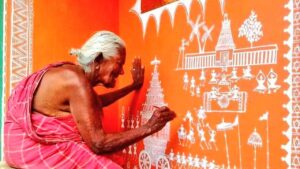The land of India is home to many folk arts, that are represented globally around the whole world. And the vibrancy it holds sparkles every eye in awe. The essentiality of such arts is the religious mystical elements, colorful patterns, and elaborative designs. And this heritage of ours is enough to feel delighted.

The popular folk arts, Pattachitra from Odisha, Madhubani Paintings from Bihar, Warli paintings from Maharashtra, and Pichwai from Rajasthan are the foremost showcased heritages of India. So, let’s discover the uncovered parts of Pichwai Paintings.
History of Pichwai Painting
The painting that has the heart of Lord Krishna, the painting that wakes up the sun of beauty, the painting that has its roots in the Sanskrit word pich meaning behind, and wai meaning hanging. Pichwai painting the traditional artwork that emerged in the 17th century at Nathdwara temple in Rajasthan has a dedication of Srinathji and the idols of local shrines.

Although Pichwai is 400-year old its foundation is even earlier. As an Indian, the epic tale of Govardhan is not unfamiliar. The story evolves when Lord Indra under his extreme rage poured thunder on the people which led to heavy floods in the city to protect his fellows little Krishna on one of his little fingers lifted the great Govardhan mountain as a form of an umbrella.
This story and its idol were found around 1400 A.D at a place near Udaipur Rajasthan. Further, this place was highly revered and a temple was constructed by the Rajputs to preserve the moment of history.
The Beginning of Pichwai Art
Not soon after the temple was created in the 16th century, the local artist began the search for decorations for the temple and landed on the Pichwai which led them to create embroidered and painted illustrations of events from Lord Krishna’s life.




They created the artwork on velvet clothes with threads and embellishments of royalty. Soon this underrated art got attracted globally and this is how Pichwai made its forever place in our hearts.
Revolution of Pichwai Painting
Pichwai paintings are notorious for their illustration of festivals such as Janmashtami, Sharad Purnima, Raas Leela, and Diwali. These paintings depict Srinathji as the central figure, for instance in Janmashtami the festival that celebrates the birth of Lord Krishna, the idol of Srinathji is placed as the center of the painting.

Rarity of Pichwai
- Pichwai Paintings are created with natural flowers, leaves, and semi-precious stones. The artwork is created from pure gold and other metals that are precious in value.
- There are no firm rules to how these paintings should be hung. This art form is purely made for art and cultural decoration.

- Pichwai is an art of endless efforts. An art with intricacy in the miniature form that has a lot of precision. One can see the detailing given by weavers and laborers.
- The devotees of Vallabhacharya caught the art that was being forgotten. These came into prominence when the sect created 24 iconic poses of Lord Krishna in the background of Nathdwara.
Check out More from Us!!
Performance Arts that are Inspired by Lord Krishna’s Literature




